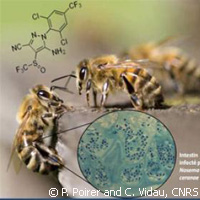Even low doses of insecticides put honeybees at risk
Scientists in France have discovered that honeybees are at a higher risk of dying from infection by Nosema ceranae (N. ceranae) when they are exposed to low doses of insecticides. The results, presented in the journal PLoS ONE, support the theory that combining more N. ceranae with a high pesticide content in beehives could contribute to colony depopulation. Some 70 000 professional and amateur beekeepers work with honeybees (Apis mellifera) in France. Experts and laypersons recognise how important a role bees play in our environment, particularly on the sound functioning of the planet's ecosystems and agricultural productivity. But bee colonies have been dealing with a mysterious disease in recent years that triggers the disappearance of thousands of colonies each year. No one knows why this is happening. A number of theories have emerged over time; some European and United States scientists postulate that losses of biodiversity and food resources, due to climate change, have intensified the problem. Others believe that a rise in single-crop farming and modification of landscapes, as well as pathogens causing diseases like foulbrood and varroasis are responsible for the problem. Researchers say that while sufficient data exists on the effects of nutritional, parasitic and chemical stress on the health of honeybees, they cannot isolate any of these factors as being the single trigger in the decline of bee populations. Experts across the board agree that studies should spotlight the combined effects of several of the factors mentioned above. Enter a team of researchers from the Laboratoire Microorganismes: Génome et Environnement (LMGE, CNRS/Université Blaise Pascal Clermont-Ferrand 2) and the Laboratoire de Toxicologie Environnementale (LTE, INRA Avignon) in France that assessed the effect of pathogen/toxin interactions on bee health. The scientists chronically exposed newly emerged honeybees, of which some were healthy and others were infected with N. ceranae, to low doses of insecticides. According to them, the infected bees died when they were chronically exposed to insecticides. Sublethal doses did not protect those bees either. The team points out that this combined effect on honeybee mortality was seen with daily exposure to extremely low loses (over 100 times less than the LD50 (Lethal Dose 50 = a dose that causes 50% mortality in a population) for each insecticide). The synergy is not contingent on the type of insecticide since the two active ingredients assessed in the study - fipronil and thiacloprid - are part of different groups. But experts have been unable to identify the mechanism that enables this synergy. In this latest study, the researchers show how the interaction between Nosema disease and insecticides generates another risk for bee populations, and could be the missing link to helping us understand why an increasing number of bees are dying. The study also highlights how insecticide doses considered to be non-lethal have a lethal toxic potential for organisms that are infested with parasites, thus making bees a lot more vulnerable. The results show that an improvement is needed in the management and protection of the bee population, according to the researchers.For more information, please visit:PLoS ONE:http://www.plosone.org/home.actionLaboratoire Microorganismes: Génome et Environnement:http://www.univ-bpclermont.fr/article148.html
Countries
France



